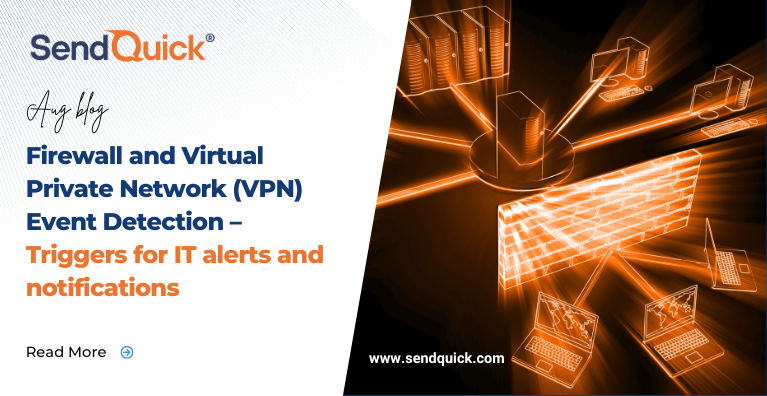There are many possible events that can be detected by a firewall or virtual private network (VPN), which are relevant to the IT security administrator and manager. In this blog, SendQuick brings your focus to events that pose potential security risks or require immediate attention from network security administrators and relevant IT personnel responsible for maintaining and monitoring network security.
These incidents will trigger alerts and notifications to be sent to their phones, ensuring prompt response from them.
Events and Alert Triggers
- Unauthorized Access Attempts:
- Description: Detection of multiple failed login attempts within a short period from a single IP address.
- Trigger: After a certain threshold of failed login attempts is reached, an alert is generated.
- Malicious URL Access:
- Description: Accessing URLs known to be malicious or associated with phishing attacks.
- Trigger: Detection of user or application attempting to access a malicious URL.
- Data Exfiltration:
- Description: Unusual volume of data transfer from the internal network to external destinations.
- Trigger: Rapid and significant increase in outbound data traffic.
- Port Scanning:
- Description: Systematic probing of multiple ports on a network, often indicating reconnaissance for vulnerabilities.
- Trigger: Detection of a series of connection attempts on multiple ports from a single source.
- Anomalous User Behavior:
- Description: Unusual user activity patterns, such as accessing resources at odd hours or from unfamiliar locations.
- Trigger: Deviations from established usage patterns.
- Malware or Virus Activity:
- Description: Presence of malicious files or activity associated with malware or viruses.
- Trigger: Detection of infected files or suspicious behaviors associated with known malware.
- Denial of Service (DoS) Attacks:
- Description: An attempt to overwhelm a network, application, or service with excessive traffic, rendering it inaccessible.
- Trigger: Rapid increase in incoming traffic, leading to performance degradation.
- Intrusion Detection:
- Description: Detection of attempts to gain unauthorized access to the network.
- Trigger: Alerts triggered by intrusion detection systems upon identifying suspicious activity patterns.
- Unusual VPN Traffic:
- Description: Abnormal patterns of traffic within the VPN tunnel.
- Trigger: Detection of unexpected and unusual traffic volume or behavior within the VPN.
- Configuration Changes:
- Description: Modifications to firewall or VPN settings, potentially leading to security vulnerabilities.
- Trigger: Alerts generated when changes to configurations are detected.
Alerting Mechanism
Upon the detection of any of the above events, an alert will be triggered, and notifications will be sent to the designated network security administrator and manager. These alerts will be delivered in real-time to their phones through a choice of social messengers, email, SMS, or a dedicated alerting or messaging application eg. Sqoope which is SendQuick’s very own enterprise messaging app for business productivity.Conclusion
This document serves as a guide for identifying, categorizing, and responding to various security-related events in a timely manner, helping to safeguard the integrity and confidentiality of the network. By actively monitoring, detecting and alerting a comprehensive set of events within the firewall and VPN infrastructure, organizations can ensure a rapid and effective response to potential security incidents.To learn more about IT alerts and notifications and other enterprise messaging solutions, please visit www.sendquick.com/contact-us/.







